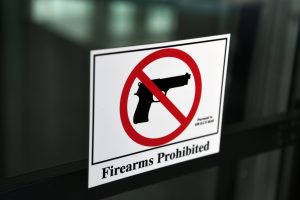Last year, 44,796 Americans were killed by a gun and an additional 40,420 more were injured in a gun related incident.1 These numbers include homicides, murders, unintentional shootings, and suicides. Since 2013, the Gun Violence Archive (GVA), an independent research and data collection organization, has been providing a verified database of incidents of gun violence and gun crime. GVA annotates each incident to its associated cause (e.g., murder/suicides, hate crimes, domestic violence, gang involvement, drug involvement, police action, robbery, defensive use) to provide U.S. citizens data to understand, discuss and potentially act on gun violence, gun rights, and gun regulations.
2021 – the worst year in firearm related deaths and injuries
The year 2020 marked the deadliest year for shooting-related incidents in the U.S. in at least two decades and then 2021 surpassed it.1
- A surprising 54% percent of the 44,796 deaths were the result of self-inflicted firearm actions (per data collected though the CDC). That breaks down to an average of 148 people each day dying by suicide with a gun. Firearms are the most common means of suicide in the U.S.2
- A total of 693 mass shootings (defined as involving four people or more who were injured or killed, not including the suspect) happened across the U.S., the most since the GVA started keeping records.
- Gun related murder-suicide incidents, erupting from domestic disputes, were at a record high of 589.
- Children aren’t spared from the spike in gun violence. A total of 5,653 children (ages 0-11) and teens (12-17) were killed or injured by firearms, a 10% increase from 2020.
These data suggest that for many Americans, gun violence is part of everyday life.
Not just numbers
No part of the country is protected from gun violence, but Americans are often unaware of firearm fatalities. A large percentage of shootings never make it to the news and the deaths of men, women, and children resulting from gun violence are not equally reported.4 Gun related deaths involving women or multiple victims, for example, are more likely reported than incidents that involve men.3 A focus on lives lost and impacted are often showcased when incidents of gun violence occur in predominantly white, affluent suburban communities.4 In many cases, the faces and lives of victims of the deadliest shootings in predominantly white, suburban communities, such as mass shootings, are chronicled by the media.3 Comparatively urban Black, Brown, and poverty stricken gun violence victims are often reported as statistics—no name provided, no humanity or emotion awarded, and no stories highlighting achievements or the impact of their losses on those closest to them.
Victims of gun violence are human beings, much more than statistics. The National Gun Violence Memorial, a nonprofit volunteer community effort, humanizes victims and the rising problem of gun violence by showing victims’ faces and telling their stories. The site includes profiles of people killed while committing a crime. The site owners explain, “We believe that every loss of life is a tragedy, and we know that even those who did horrible things have friends and family who miss them and wish that they made different choices in life…we do not try to hide or obscure the facts. We provide links to news articles that describe each incident.”5
Causes for the increase
There is no one clear reason, however, experts note an association with COVID-19 trends. The rise in gun violence corresponds with increased alcohol use, drug overdoses, increased gun sales, unemployment claims (increased financial insecurities), and motor vehicle deaths. COVID-19 marks “a sea change in psychology,” said Frank Farley, a professor of psychology at Temple University in Philadelphia. Social distancing and stay-at-home orders may not have decreased risk-taking behaviors as some might have predicted. A dramatic rise in traffic fatalities, for example, has been attributed to a form of rebellion from being cooped up and locked down.
As one might expect, the chance of being shot by a firearm increases as more guns are present in U.S. communities. The academic literature is clear on the association. Where there are higher levels of gun ownership, there are: (1) more gun suicides and more total suicides, (2) more gun homicides and more total homicides, and (3) more accidental gun deaths.6

The impact of gun violence on workplaces
Gun violence happens everywhere — in homes, schools, communities, places of worship, and workplaces. The emotional, physical, and financial impact is likely being felt by your employees, colleagues, and customers.
Gun violence costs the American economy billions of dollars every year in lost wages, productivity, and medical costs7. People who survive a firearm-related injury may experience psychological trauma and reduced quality of life (e.g., post-traumatic stress disorder, problems with memory, thinking, emotions), physical disability from injury to the brain, paralysis from injury to the spinal cord, steep medical costs, and loss of productivity and work. Estimates suggest that work loss totals an average of $50,787 for each survivor of a firearm assault.7,8 These challenges can make work difficult or impossible.
Areas that experience frequent gun violence are less likely to see economic growth and commerce, face lower property values, and increased unemployment. Workplace mass shooting incidents can affect the sense of safety and security of employees.
Employees are affected when co-workers, clients, vendors, and others in their work team die by suicide. The resulting grief may be characterized by shock, confusion, feelings of guilt, shame, and anger in varying degrees among remaining team members.9 Employees may feel extreme guilt believing they should have noticed a co-worker’s struggles before the suicide.10
Additionally, people may be unsure how to respond to a co-worker who had a suicide death in the family. Stigma, defined as a mark of disgrace, is often associated with a suicide death and can lead to social isolation, demoralization, the feeling of hopelessness, a decrease in productivity and workplace morale.10
Solutions leaders can bring
Every organization can do something about gun violence in America and expectations to act are growing. A recent poll found Americans overwhelmingly believe companies have the power and responsibility to influence gun safety.11
Leaders have a critical role to play keeping customers, employees, and communities safe and you may be closer to the solution than you think.
 1. Take a stand on gun safety in your organization by banning open carry firearms in your facility(ies). Check out the gun safety scorecard here. Is your organization or favorite business keeping you safe from gun violence?
1. Take a stand on gun safety in your organization by banning open carry firearms in your facility(ies). Check out the gun safety scorecard here. Is your organization or favorite business keeping you safe from gun violence?
- Help employees cultivate resilience. Resilience-building increases individuals’ ability to bounce back from adversity.
- Increase social connectedness and support especially as the pandemic lingers on. Social and emotional support are critical to leaders’ overall wellbeing now, more than ever. Meaningful connections are achieved through developing better skills for building relationships such as listening, communication, empathy, and cultivating trust. Meaningful connections at work can lead to increased happiness, reduced stress, and increased engagement.12
- Ensure that crisis services are available to anyone, anywhere, at any time. Leverage your health care benefits to enhance (prevent and treat) employee mental health and have an Employee Assistance Program (EAP) or something like it available for all employees.
- Support Employee Resource Groups (ERG) who connect to share their members’ experiences with gun violence and/or suicide. Sharing stories can be a powerful way to increase understanding, reduce stigma, promote respect and compassion for victims, while increasing personal connection to others who are experiencing something similar.
- Speak up regarding the importance of sustaining wellness and seeking mental health supports as the COVID-19 pandemic continues. Know that factors—such as lack of access to well-paying jobs, safe housing, enough food, high-quality education, and effective health care services—are likely impacting your employees.
- Provide training on workplace violence and safety. Some police departments offer “active shooter” training. Additionally, the Department of Homeland Security has resources available to the public.
- Support research, especially longitudinal studies, on the effectiveness of gun prevention initiatives, gun safety training, victim storytelling, and suicide prevention.
- Educate yourself about gun violence by reading the American Psychological Association Resolution on Firearm Research and Prevention and the American Psychological Association Panel of Experts Report, Gun Violence: Prediction, Prevention and Policy. Explore FBI Uniform Crime Reports.
- Educate your managers and employees about suicide warning signs and appropriate action. The National Suicide Prevention Lifeline lists warning signs and suggestions for co-workers. Read A Manager’s Guide to Suicide Postvention in the Workplace.
References
- The Gun Violence Archive (2022, January). Past summary ledgers. https://www.gunviolencearchive.org/past-tolls
- S. Department of Defense. (2019). DoDSER: Department of Defense Suicide Event Report: Calendar year 2018 annual report. https://www.pdhealth.mil/research-analytics/department-defense-suicide-event-report-dodser
- Kaufman, E. J., Passman, J. E., Jacoby, S. F., Holena, D. N., Seamon, M. J., MacMillan, J., & Beard, J. H. (2020). Making the news: Victim characteristics associated with media reporting on firearm injury. Preventive medicine, 141, 106275. https://doi.org/10.1016/j.ypmed.2020.106275
- Jackson, G. (2021, December 14). Media inconsistent in telling the stories of gun violence victims. The Baltimore Sun. https://www.baltimoresun.com/opinion/op-ed/bs-ed-op-1215-gun-violence-victim-portrayal-20211214-2m7eccvoz5gyndik6qmwc7skg4-story.html
- National Gun Violence Memorial (2022, January). About us. https://gunmemorial.org/about
- Miller M., Azrael D., & Hemenway D. (2013). Firearms and violence death in the United States. In Webster, D.W., Vernick, J.S., (Eds.) Reducing gun violence in America. Johns Hopkins University Press.
- Everytown (2022, January). The impact of gun violence on business in the U.S. https://everytownsupportfund.org/initiatives/business-leaders/impact-of-gun-violence-on-business/
- Zonfrillo, M.R., Spicer, R.S,, Lawrence, B.A., & Miller, T.R. (2018) Incidence and costs of injuries to children and adults in the United States. Injury Epidemiology, 5(37): 1-6.
- Kučukalić S. & Kučukalić A. (2017). Stigma and Suicide. Psychiatr Danub, pp. 895-899. PMID: 29283986. https://pubmed.ncbi.nlm.nih.gov/29283986/
- Center for Workplace Mental Health (2022, January) Suicide prevention & response: new tools help employers take action. https://www.workplacementalhealth.org/mental-health-topics/suicide-prevention
- Ambler, P. (2021, March 16). Businesses belong in the gun safety fight. Giffords. https://giffords.org/blog/2021/03/businesses-belong-in-the-gun-safety-fight/)
- Kohll, A. (2018, January 31). 5 reasons social connections can enhance your employee wellness program. Forbes. https://www.forbes.com/sites/alankohll/2018/01/31/5-ways-social-connections-can-enhance-your-employee-wellness-program


